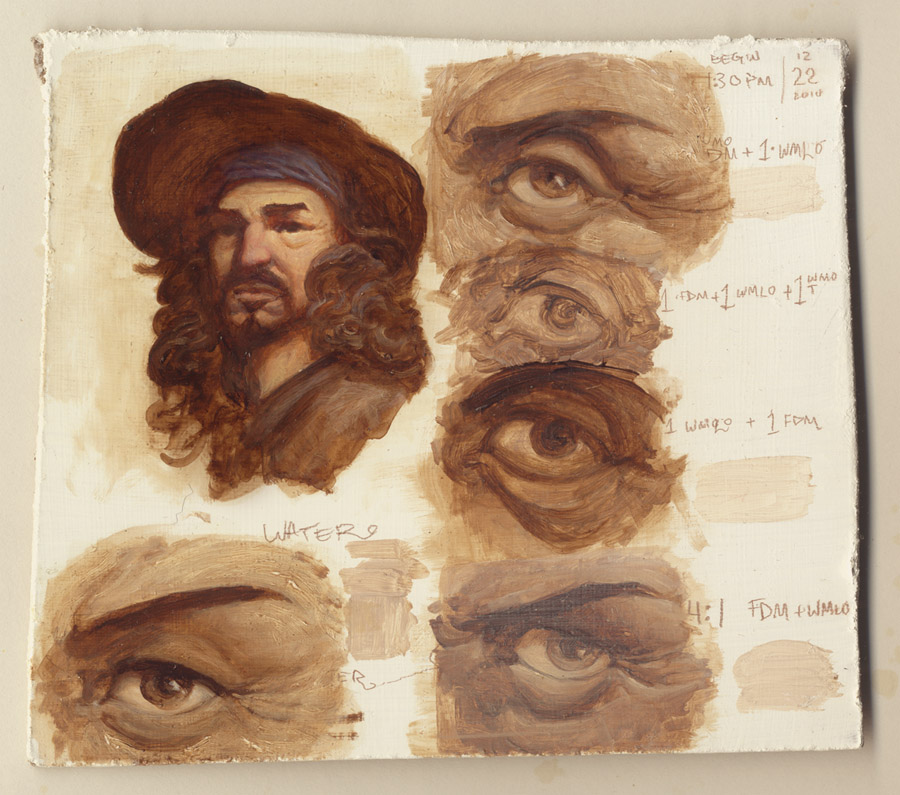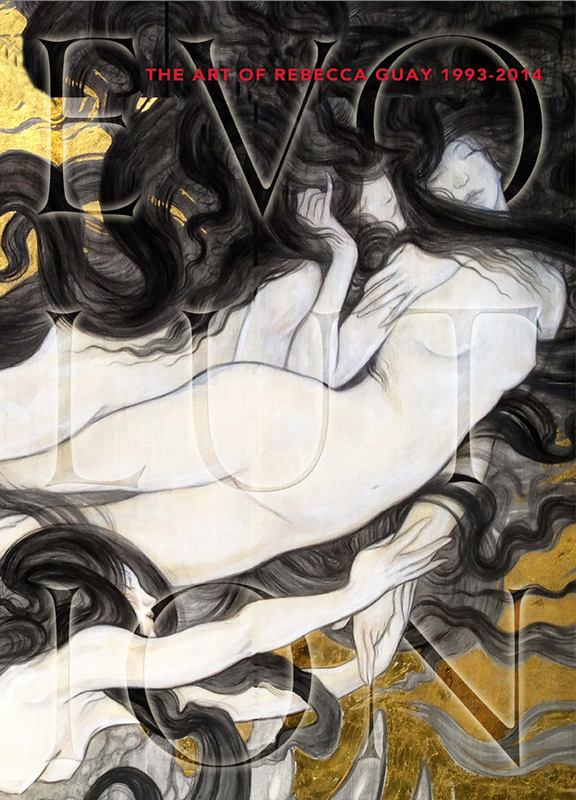By Justin Gerard

The Problem
1. That the paint itself will allow for a smooth, buttery application consistent with that of traditional oil paints.
2. That the final product will be archivally sound. (It will allow for thick over thin, it won’t lead to long-term cracking, the colors won’t yellow unreasonably fast. etc.)
3. That if needed, a layer could be touch-dry, ready-to-paint-over in 24 hours. (While staying workable on palette and canvas for at least 8 hours.)
4. That I can work in a non-toxic studio environment. (Here I am concerned mostly with the fumes. I don’t plan to eat any of the materials.)
To find a paint medium that had all 4 proved to be a lot harder to find than I originally thought. Most products and mediums out there could give 3 of the 4, but very few could deliver all 4.
I spent a lot of time talking with the manufacturers about it and most of them recommended I try water-mixable oils.
Easy clean up, non-toxic, faster drying times. It sounds great.
I started doing experiments with these a year ago and have done a lot off and on since then.
After a great deal of testing, and several pages of notes I concluded that they failed the 4-point test because they cannot deliver on #1.
-I also found that the paint layer wouldn’t dry for days. Especially if there were any whites in it. (Winsor and Newton uses Safflower oil in their Artisan whites. Safflower will keep the whites whiter over time, but it tends to be extremely slow drying.)
-When working with the water-mixable Linseed Oil, (either alone or mixed with water) The paint is slick and a little more predictable, but it never dries. Fail on #3. And if it has to be heavy, and isn’t any faster, I might as well just work with traditional oils and walnut oil. It would be just as safe and the clean-up wouldn’t take much longer.
-When working with the Fast Dry Mediums:
Alone, they are impossible. They tack up within minutes and leave that area an unworkable syrup for at least the next 12 hours.
They cannot be mixed well with water for some reason. (This shouldn’t be surprising, since we are mixing oil and water after all.) They tend to foam up and turn into a mess.
This leaves mixing the fast dry medium with the linseed oil mediums. Mixing these 2 together produces a reasonable working medium. However, it only marginally improved the overall application of paint. It wasn’t as frustrating as just water, but it was still contrary. If I mixed it heavier on the fast dry side, it turned to syrup too fast. If I went too heavy on the Linseed oil side, it stayed workable for longer, but might remain an unworkable syrup for days after. There was no perfect mixture that I found suitable.
So my notes lead me to think that water-mixable oils are too much of a fight to justify switching over.








Hi Justin,
I've been using WMO's for about 4 years. I absolutely love them. To comment on a couple of points:
1) Yeah, don't use water. Almost everybody that tried to use water as a medium for it, hated the paints. I use the Holbein Duo's. I tried the Winsor Newton ones, first and had the same problem (Too tacky/stiff without mediums). However, the Duo's are pretty creamy (not as creamy as traditional oils), but pretty good.
3) If you need a layer to be touch-dry in 24 hours or doing a lot of glazing layers, use Liquin. The trick is that you actually use a touch of liquin…. not a lot. For me, since, I paint alla-prima, I tend to only use the liquin/paint mix for toning the canvas.
I originally got the stuff (rather than trying traditional oils) due to the fact that I wanted to paint in my living room and my wife has an incredible sense of smell. The normal cleaners, etc gave her headaches.
Dougie
Hi Justin,
You can use Oil Spike of Lavender. It is one of the oldest known turpentine substitutes, and it is very safe and slightly stronger solvent, it also possesses a most wonderful scent (it is used in aromatherapy). Oil Spike of Lavender is the essential oil from the lavender plant. You can mix it with stand oil in various proportions, and use it with regular oil colors.
Oil Spike of Lavender/stand oil medium can help you with 1,2 and 4, but for 3, it is average, aldough much faster drying than pure water-mixable linseed oil or walnut oil. Depending on proportion of lavender/oil it has different drying rates, on average between day and two, in my experience.
Have you tried using Alkyds with the slow drying mediums/walnut oil?
I took a tip from Manchess and use Alkyd white to speed up drying time. I personally think the alkyds dry too fast, but when mixed with traditional paint it seems to strike a balance of handling time to drying time.
I've tried the H2O oils and the consistency of the paint always kind of reminded me of cold creme, I never warmed up to it.
But, on the other hand I have recently used Golden's Open Acrylics which come at the problem from the opposite direction…acrylic paints that act like oils. The brush handling and drying time and color is VERY much like oil paint…much more so than any water mixable oils I've tried.
http://1.bp.blogspot.com/_qeCrHnZ4P9A/S5zm8S4hkeI/AAAAAAAABJA/JcKGl6KrQR8/s1600-h/OPEN_ACRYLICS_PAINTING_by_doonboy.jpg
I paint in oils and have over 10 years experience in an art store, and one of the most frequent misunderstandings about oils is that their toxicity is unavoidable.
In reality, there are multiple brands of non-toxic solvent on the market now, from Eco-Turp to what Dragan suggests above, oil of spike lavender, to my favourite, Turpenoid Natural, which is even available in an unscented form.
Over the years, I heard a lot of people complain about the fumes bothering them – but oil paint left open is akin to olive oil open while you dip bread. It's the toxic solvents -even odorless ones- that are dangerous.
That said Justin, all paint lines -acrylic, oil, watercolor, gouache, may have some toxicity depending on what pigments are in the line. In Artisan, you can get ones with real Cadmium or real Cobalt, in which case it's dangerous to inhale if you spray paint with it. The mineral pigment is bad for your lungs.
Even the generally safe umber browns can have deleterious health effects if the vehicle mixture is insufficient and they start to dust on the surface: they're mostly silica, and the dust ain't good for you.
Traditional oils can be as safe as any other type of paint if you use the right non-toxic solvent.
(Sorry for the wall of text).
Just wanted to pipe up and say “What Dougie Said”-
I also use WMO's and love them. I don't use the water as a medium unless I'm laying down an underpainting. (I don't use white in my underpaintings either.) The water is just there to clean up my brush.
Also note, WMO's can be mixed with traditional oils and mediums. So long as you keep it at around a 70/30 mix (WMO's in the majority) it'll retain it's water-mixableness. ^_^
This is actually a great topic. I have friends who have used WMO and I have tried them a few times. They have all gone back to regular oil paint. The thing is i agree with Glendon, The paint is no the problem. Using water as a medium for WMOs only works like turps at a very thinned underpainting sort of thing and for cleaning up. So one is left with what to use as a medium. Back to the old problem. Having oil paint that cleans up with water doesn't seem like enough of a benefit to override its other problems.
These are great! Thanks for all the feedback everyone.
Dagan, I have not used oil spike of lavender yet, but I have heard a lot of talk about it. I definitely need to give it a try.
Pete,
I love alkyds, they were the paint I was using when my friends jumped me about all the hazards. I was using the Griffin alkyds, which are just a spectacular set of fast-dry oil paints. I would thin them with liquin+oms, or as you mentioned, with something more slow drying. But I still ran into the problem that even the paints themselves have a warning label saying: “Vapor Harmful.” (My understanding is that the vehicle in the tubes is the same one that is in liquin.) But perhaps that is just Griffin. Which alkyds are you using for your work?
This also relates to Dougie and JulieD's comments. I had heard the liquin itself gave off harmful vapors even without solvents added in. But maybe because you guys are using such small amounts it isn't giving you any ill effects. It is a great idea mixing the 2 but I still think it would tend to seize up once you added mixed it in with the water mixables paints. Do either of you add some further medium in to smooth its consistency? Or do you not find it tacking up?
Bill and Glendon,
You guys have said it, it's what to use as the medium that is presenting the biggest issue. The reason I had jumped on the water-mixables is not because of the paints themselves (I don't plan on sanding or spraying or anything) but because I could use water as a medium, which would cut down on any vapors. What could be safer than water right? But it has proved to be a little bit more tricky than i had expected.
Justin,
I use sooo little liquin that it's almost not noticeable. I find the WN tacky, but the Holbein's not so.. unless I use a lot of titanium white. The titanium white is very tacky. So, to counteract that, I find that using a lot of paint helps (Also, I paint alla-prima so I DO use a lot of paint).
If you are going to use water, I would recommend that you use just dip the tiny little tip of your brush into water. That's all. It'll make it a lot smoother. With water, it's really really easy to go overboard.
I also agree that, if it wasn't for my wife's incredibly strong sense of smell (yes, she can even smell the liquin), I would use traditional paints.
Dougie
I'm with you Justin. The one alternative to oils that I absolutely love is Casein paint. I love that I can lay them on like an acrylic or oil, but can thin them down and use them as a watercolor if needed. I am an inpatient painter so fast dry times aren't a problem for me. But with Casein I can work on a “dry” layer even up to 8 hours later by incorporating a spray bottle.
How about water mixable thinner? have you tried that? http://reprographicscatalog.org/artisan_water_mixable_thinner_250ml-p-1223092.html?osCsid=6812a2a065a9accb46e33be41318616b
Hi Wouter,
I have, and it has the same effect on the paint and other Artisan mediums as normal water. (I am still a bit suspicious that it actually is just water…)
Shawn,
I have not tried Casein but would like to. I understand that they are milk-based. Are there any drawbacks to this in your experience? Also, what brand are you working with?
Bah!
Everyone knows REAL artists have cancer.
Seriously though, I'm curious about the cadmium colors.
Do the water-mixable oils still use cadmium in the yellows and reds?
After all, if there are decent substitutes for those colors, the solvent issue is the only real problem, and that is easily remedied… just don't use it.
That's interestin, Dan. @Jusin, thanks for your helpful information. I have recently tried Cobra paints . The are also water mixable oils. The pigments are great, however the ultramarine blue tends to dry much too fast…
Has anyone tried Weber's wOils? Thye can be mixed with regular oils as well as watercolors and acrylics?
I really like the genesis paint which is a heat setting polymer. I got some before it was released in the 90's from a trade show. You can paint and blend like oils and the paint won't dry till you heat it with a heat gun or in an oven. I have paintings that are 15 yrs old that show no change at all. I talked to the techs at the company and think they've done a good job. The paint was developed by John Pitre and his studio assistant. I have paints that are in jars open for 15 years and there as good as when I got them. If you like glazing they're great glaze hit it with the heat gun glaze again. You can use rubbing alcohol as a solvent to clean up.
Water Mixable Oils are still for the most part linseed oil based, therefore will not dry faster than regular oils. They were designed for people who developed an allergy to turpentine/oms. Their water solubility is intended for cleanup rather than painting, and are fully compatible with traditional oil mediums. I'd stay away from the Artisan line, they use the same student grade pigments that the Windsor & Newton Winton paints use.
Cadmiums, Chromiums, Cobalts and Manganese are still used in the pigments for them, and can be carcinogens. However, for them to turn into carcinogens they need to be ingested first. They are safe to use so long as you don't get them in your mouth. Wear gloves and wash your hands thoroughly before eating.
Solvents are a tough cookie. I've always been of the camp that if you have to start an underpainting with lean oil layers then why not just use watercolors (w/ fixative) or thinned acrylic instead. Then for fatty layers on top apply liquin thinned oils paints and there is no need for a solvent. To clean the brush for a new color or load rinse in a jar of cheap drying oil like safflower, dab on a cloth to remove excess oil and when you are done using for the day clean all brushes in a strong detergent/water solution.
Have you tried Golden Open Acrylics? I'd be interested in your thoughts.
In terms of solvents used for regular oils (when I can afford it) I choose Gamsol, from Gamblin, as it is lowest in toxicity among regular solvents. Found this little blurb on their website… (http://www.gamblincolors.com/solvents/index.html)
“Gamsol is special: it is made for products and processes that come into more intimate contact with the body such as cosmetics, hand cleaners, and cleaning food service equipment.”
I've found it particularly effective in longer figure drawing/painting sessions when participants are very sensitive to aromatic solvents. Gamsol really doesn't seem to affect them as much/if at all.
I just tried working with Gamsol based on the ad blurb you referred to. My experience was that it burned my lungs and sinuses. it took almost a month for my lungs to normalize and I still have problems with my voice 5 weeks later. I used the product with open ventilation and a fan blowing the fumes away from me to the open door. i liked painting with it on the initial layers of my painting and liked the results. I then purchased a high end air purifier that specialized in removing VOCs to see if I could continue using Gamsol. I started having the burning sensation in my throat again. No more Gamsol for me, ever.
@Dan…I've actually found it very surprising when I find that paint makers use actual cadmiums and cobalts in their acrylics and watercolors.
I'm not so much worried about the toxicity to myself, but more so to others when I would have to dispose of the solvent (water) once I have rinsed my brushes; in terms of safety, I'd rather use oils and OMS and a trusty brush washer than risk exposure to others in that regard.
As for the leftover contaminants from oils in the brush washer, you can always take out/mix the sludge with an alkyd binder such as Liquin and use it to prime boards/canvases. Gives a nice neutral tone, with no waste and reduced risk to others.
I've never found any use for solvents whatsoever when painting with oils. Brush cleaning? Regular hand soap is all you need. If I need to rinse a really loaded brush, I do it in pure linseed oil. Medium? Again, I use linseed oil, sometimes mixed with chalk to make a putty that works nice as a slightly thicker medium. The main challenge is #3 – the drying time, but here, the choice of pigment can have a lot to say. If raw or burnt umber is a part of the mix and it's a reasonably thin layer, it will usually be dry to the touch within 24 hours.
I have not tried the Weber or Genesis products yet. The heat drying sounds interesting. I will have to look into those.
Curious,
I have tried Golden Open before but wasn't very successful with them. I felt like there was a lot of unnecessary fighting with them. They may just require some getting used to though.
Cegebe,
I agree with you about the cleaning aspect. I have never needed to use anything more than soap and water to clean brushes, and I haven't lost any in years. Solvents aren't necessary for that.
Joey,
I have done a few paintings for gallery work in this way (pencil then watercolor, then acrylic barrier layer, then oil, then final glaze) and I really like the effect. I think it's a good solution to the overall problem of avoiding solvents.
The Liquin may still present a small problem here because I believe it gives off vapors even without adding solvents. But still it would have to be safer/less toxic than using solvents the whole time.
There's also M. Graham Walnut Alkyd Medium. I attended a workshop with David Kassan, and he uses it a lot. It dries overnight and as I recall it, it didn't smell the way Liquin does, so I guess it's safer in terms of vapors. I don't use it a lot myself – speeding up drying time is mostly something I would want in the first layers, and it seems to be a rather fat medium (almost pure walnut oil), so I usually stick to relying of umbers in the mix.
I have the luxury of not being a pro illustrator with deadlines and stuff to worry about, but if I was in a hurry and really needed an underpainting to dry quickly, I would probably go for the acrylic first layer, like Joey suggests.
This post, and subsequent comments have been full of so much useful information. I'm enjoying the back and forth! Justin, thanks so much for sharing your experiences.
I started using WMO's recently because I was really interested in oils, but didn't want to deal with harsh chemicals. I don't use water as a thinner and instead use W&N WMO Thinner or Medium.
I find the texture of WMO so much more pleasing than Open Acrylics. It has that buttery consistency I see others describing towards traditional oils.
Which makes me really curious, so are traditional oils then even nicer than the water mixables? I really want to try them out now.
So what's turpenoid/turpentine used for with traditional oils? Is it a thinning agent? Cleaning solution? If I wanted to experiment with traditional oils, what would I need as a minimum to get started (aside from the oils themselves).
Thinner:
Medium:
Cleaner:
Anything else?
Justin,
Liquin. Hmm I didn't think of that. Looks like Cegebe has a fairly good solution with the Walnut Alkyd. I need to check that out myself. Can you direct us to a link of one of those gallery pieces with the watercolor/acrylic/oil hybrid? I'm eager to see your approach!
Very interesting discussion, here are a few of my thoughts:
Golden Open acrylics: Very very transparent and they lack the buttery consistency of oilpaint, (I found using an underpainting with traditional acrylics can be useful)
Talens Cobra: Tacks up really fast, didn't like that the darker colors (temporarily) lighten when you mix them with water.
Artisan: Different consistency between colors, student grade. I did like the Artisan thinner though, it worked better than thinning with water. It's definitely not water 🙂
Currently I'm using regular oils of different brands, wash my brush in a brushwasher filled with walnut oil and for a medium I use M Graham Walnut Alkyd thinned with a bit of Sansodor for the first layers. When I don't use the medium I keep the lid on to prevent fumes from getting out. And I use a nitril glove to prevent toxic paints from getting into my skin.
PROFESSOR EMERITUS PETER BAGNOLO said…
Hi Justin. I had no such trouble with Holbein, but then I tend to paint very fast and use very little thinner, whether linseed oil, water, Walnut oil or safflower oil. I was able to work well into the day from start and well into the following days.
I found Holbein very easy to work with, but as I said, regardless of weather I use; oil or alkyd or Grahams acrylic, when mixing colors, the consistency of each color is usually the same out of the tube as after mixing ala prima. Only when I under-paint do I thin.
I did not like Winsor Newton brand of water mixables (Artisan) for some of the same reasons others here mentioned. I use WN regular oils with no thinner or mixing agent, just Ala Prima. I also use Sennelier Safflower based oil, Graham walnut based oils, Graham acrylics (best I have ever used) Rembrandt regular oils, WN alkyds and others.
I painted with regular oil & and turpentine for years and then started having rashes, dry mouth/lips, itchy red face and burning eyes and throat and the doctor said it was best to not use paints with solvents and avoid Turpentine and anything like it not even the supposed low toxic synthetics.
Steve Hanks now paints only with water colors because of allergies/sensitivities to petroleum distillates and says it is a rather widespread thing. Turpentine is, of course, a very toxic solvent and will catch up with MOST, but not all, people, unless they do all of their painting out of doors. Having good air circulation and high ceilings (Mine are 19 feet high at the apex in the studio) and large sq footage makes the concentration diluted PSQF and lots of open windows helps. I have clerestory windows all around three of the four walls. Thanks for the input/forum it was interesting.
See my work at: http://www.Bagnoloart.com
May be a little late, but nevertheless… 🙂
http://www.zest-it.com/zest-it.htm
Since I do not have a studio and work in my living room, I use traditional oil paints with zest-it instead of turps for paint thinning and brush cleaning. It's completely non hazardous and safe, plus it smells good (if you happen to hate citrus smell for some reason, they do have a citrus free version) 🙂
You guys can check out the full description and the testimonials page.
I am also using WMO..If you mixing it in a proper manner it will give a good result to you…
Wow, such great info. Thanks for starting this discussion, Justin. I've also just started using the WMOs and was discouraged by their tackiness. Did I read you right in that you found the WM thinner did NOT solve the problem with the oils being tacky? I found that result when only using water as my medium (which now, after reading many others' comments I will NOT do) resulted in tackiness.
Also, did you find that the MW fast-drying medium produced a syrupy result? That was my experience but wanted to see if I was using it wrong. Thanks!
Thanks for making my morning a little bit better with this great article!!
All Size of Cosmetic Tubes
Michael Harding oils & no solvent whatso ever. The paint is pure pigment & oil. The thing is for 100 years, artists got used to the plastic binders in substandard oil paing that requires OMS/turps.
Rembrandt mixed his own paints, pigment & oil only, & never used a thinner.
Once I discovered MH, I threw away my “childhood” paints & never looked back.
The best soap for cleaning brushes is Kirk’s Castile. Breaks up even dried paint, doesnt harm the bristles & the residual coconut oil conditions them. $5 for 3 bars. Cheaper than “brush cleaners” & safe on your hands.
Thanks for information
My best mixes for water mixable mediums in WMO oils are half Safflower oil and half Painting Medium. These are all Winsor Newton Water Mixable Oil Mediums. Sometimes I increase the Safflower oil to keep the paint more fluid for extended use. However, I use The Painting Medium or Fast dry Medium if I know the area has to be set faster.
I have used the Linseed Oil Medium and The Stand Oil; these two are much slower drying but OK if that’s the intended purpose. I have found that all the manufacturers of WMO paints have different qualities, but I like them all. It’s mostly about getting used to how the paint drys, its appearance, juxtaposing colors, and anticipating these effects. I like oiling out with the above half and half mix as it responds to the next layer, usually the next day, as long as I am layering thin in each indirect stage.